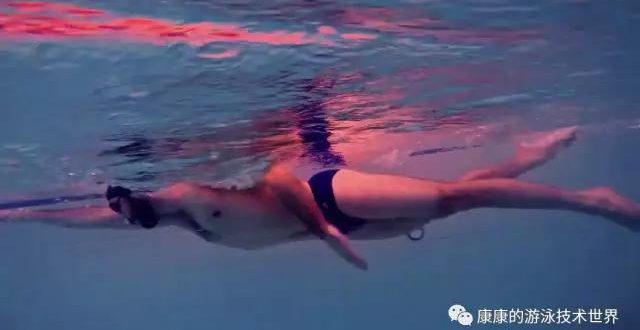自由泳期間的呼吸是一件有趣的事情。當你擅長時,很難明確說明它為什麼起作用 – 它就是這樣。當你不在的時候,這就是你所想的,這使得游泳思維麻木起來難以啟動。
考慮到這一點:在自由泳的一個周期內,游泳運動員需要在兩次擊球的範圍內精確完成15個不同的運動。儘管大多數運動員都在多任務處理,但在很短的時間內仍然是一系列非常複雜的動作。
運動的這種複雜性會導致游泳者呼吸和游泳的方式出現很多不同類型的問題。我們與SwimLabs的鐵人三項運動員一起工作的最常見問題之一是通過滾動他們身體呼吸的游泳運動員。在游泳世界中,這被稱為「過度旋轉」或「不平衡」的呼吸。
呼吸過度旋轉有一個巨大的障礙:人體不能漂浮在這個位置。下一次你去游泳池,試試這個小實驗,看看為什麼:在你的身體上浮動,頭部處於呼吸狀態。最有可能的是,這會使你很快下沉,就像你在呼吸時過度旋轉一樣。這使得在游泳中始終如一地使用好技術變得更加困難。
解決這個問題需要了解一些關於游泳自由泳時身體旋轉的工作方式。在游泳世界中,自由泳被稱為「長軸」中風,這意味著當他們的手臂在水中衝擊時,游泳者的身體沿著脊柱的線從一側到另一側旋轉。通常,大多數游泳運動員相對於表面在20至45度之間旋轉。還有一條通用的經驗法則,即如果游泳者旋轉超過45度,則會下沉。
保持呼吸中的平衡關乎一致性。理想情況下,呼吸和無呼吸行程時的旋轉角度應該完全相同。這使你更容易保持身體在水中的平衡。這將幫助你減少你的中風數量,從而導致更高效(通常更快)的游泳。
要做到這一點,需要做以下兩件事:1.您需要在中風早期開始呼吸運動,並且2.您需要確保您的身體永遠不會在水中旋轉超過45度。
我不知道你的情況,但我不會把量角器帶到水池裡,即使我這樣做了,我也不知道在游泳時如何測量自轉。幸運的是,對我來說,知道自己旋轉得多麼重要,因為它知道我不會旋轉到很遠,而「肚子鑽」是一個很棒的練習,可以提供精確的信息。
肚臍鑽被設計為做兩件事:1.它允許游泳者「感覺」早期呼吸啟動感覺是什麼樣的,並且2.它使呼吸期間過度旋轉非常困難。這兩件事使它成為在平衡呼吸時使用的完美演習。
肚子鑽可能是您學習過的最簡單的練習之一。雙臂伸展在你面前,從「超人」的位置開始。保持一隻手臂在那個位置,並將你的手撫摸到你的肚子。當你抬頭呼吸時將它留在原地。一旦完成,完成該手臂的撫摸動作,並開始用另一隻手臂撫摸。在進行此練習時,最好在呼吸之間進行平均數量的運動,以便儘可能保持運動一致。
肚子鑽套裝
注意:在SwimLabs中,我們使用這個更長的集合與很多我們的客戶。做這種設置可以確保你能夠在比賽日保持這種長距離的呼吸。
重點:這次演習的重點是保持呼吸時的平衡,並且正確地協調你的呼吸。
2×100自由式肚子鑽:呼吸x 4(休息10或15秒)
2×200自由式呼吸x 4(休息15秒);保持平衡的呼吸
事實上,無論你嘗試多麼努力,除非你呼吸正常,否則你不能游泳自由泳,並且在自由泳中適當地呼吸是困難的。如果你花一些時間學習如何在呼吸中保持平衡,那麼你會很好地沿著優化你的呼吸方式,以便在比賽當天能夠更快地游泳。
需要讓它更容易?
站在底部並拿著水槽時,嘗試相同的呼吸模式。
當你游泳的時候,在頭上重複一個模式,比如「肚子,呼吸,1,2,3,4」,這樣可以更容易地確保你完成每次動作。
不要急於!如果游泳速度較慢,則進行演練會更容易。
Breathing during freestyle is a funny thing. When you are good at it, it’s hard to articulate exactly why it works—it just does. When you’re not, it’s all you think about, and it makes swimming mind-numbingly difficult to boot.
Consider this: within one cycle of freestyle, a swimmer is required to precisely complete upward of 15 distinct movements within the span of two strokes. As good as most athletes are at multitasking, that’s still a very complex series of movements within a very short period of time.
This complexity of movement can lead to a lot of different kinds of problems with the way a swimmer breathes and swims. One of the most common problems that we work with triathletes on at SwimLabs involves swimmers who breathe by rolling onto their side. In the swimming world, this is known as an “over-rotated” or “unbalanced” breath.
Over-rotating during the breath has one colossal hitch: The human body is just not built to be able to float in this position. The next time you go to the pool, try this little experiment to see why: Float on your side with your head in a breathing position. Most likely, this will cause you to sink very quickly, just as you would if you over-rotated during your breath. This makes it much more difficult to consistently use good technique as you swim.
Fixing this problem requires understanding a little bit about the way body rotation should work when swimming freestyle. In the swimming world, freestyle is known as a “long axis” stroke, meaning that a swimmer’s body rotates from side to side along the line of their spine as their arms stroke through the water. Typically, most swimmers rotate somewhere between 20 to 45 degrees relative to the surface. There is also a general rule of thumb that says that if a swimmer rotates more than 45 degrees, they will sink.
Maintaining balance during the breath is all about consistency. Ideally, your rotation during breathing and non-breathing strokes should be exactly the same. This makes it easier for you to keep you body balanced in the water. This will help you reduce your stroke count, leading to more efficient (and usually faster) swims.
To be able to do this requires that you do two things: 1. You need to initiate the breathing movement early in the stroke, and 2. You need to ensure that your body never rotates past 45 degrees in the water.
I don’t know about you, but I don’t carry a protractor with me into the pool, and even if I did, I have no idea how I would measure my rotation as I swim. Luckily, It’s not as important for me to know exactly how much I rotate as it is to know that I don’t rotate to far, and “tummy drill” is a great drill to use that provides that exact information.
Tummy drill was designed to do two things: 1. It allows a swimmer to “feel” what an earlier breath initiation feels like, and 2. It makes it very difficult to over-rotate during the breath. Both of these things make it the perfect drill to use when working on a balanced breath.
Tummy drill might just be one of the easiest drills you ever learn. Start in “superman” position with both of your arms extended in front of you. Keep one arm in that position and move your stroking hand to your stomach. Leave it in place as you move your head up to breathe. Once you do, finish the stroking movement of that arm and begin your stroke with your other arm. When doing this drill, it’s a good idea to take an even number of strokes between breaths so that you can keep the movement as consistent as possible.
Tummy Drill Set
Note: At SwimLabs we use this longer set with a lot of our clients. Doing this kind of set ensures that you are able to maintain this kind of breathing for longer distances, as you would on race day.
Focus: This drill is all about staying balanced when you breathe, and properly coordinating your breath to your stroke.
2×100 Freestyle Tummy Drill: Breathe x 4 (10- or 15-second rest)
2×200 Freestyle Breathe x 4 (15-second rest); maintain balanced breathing
The fact of the matter is, no matter how hard you try, you can’t swim freestyle unless you breathe properly, and breathing properly in freestyle is hard. If you spend some time learning how to stay balanced in your breath, you will be well along your way toward optimizing your breath in such a way that you will be able to swim faster on race day.
Need to make it easier?
Try the same pattern of breath while standing on the bottom and holding the gutter.
Repeat a pattern to yourself in your head as you swim, such as “Tummy, Breathe, 1, 2, 3, 4). It will make it easier to make sure that you complete each movement.
Don’t rush! If you swim slower, it’ll be easier to do the drill.
